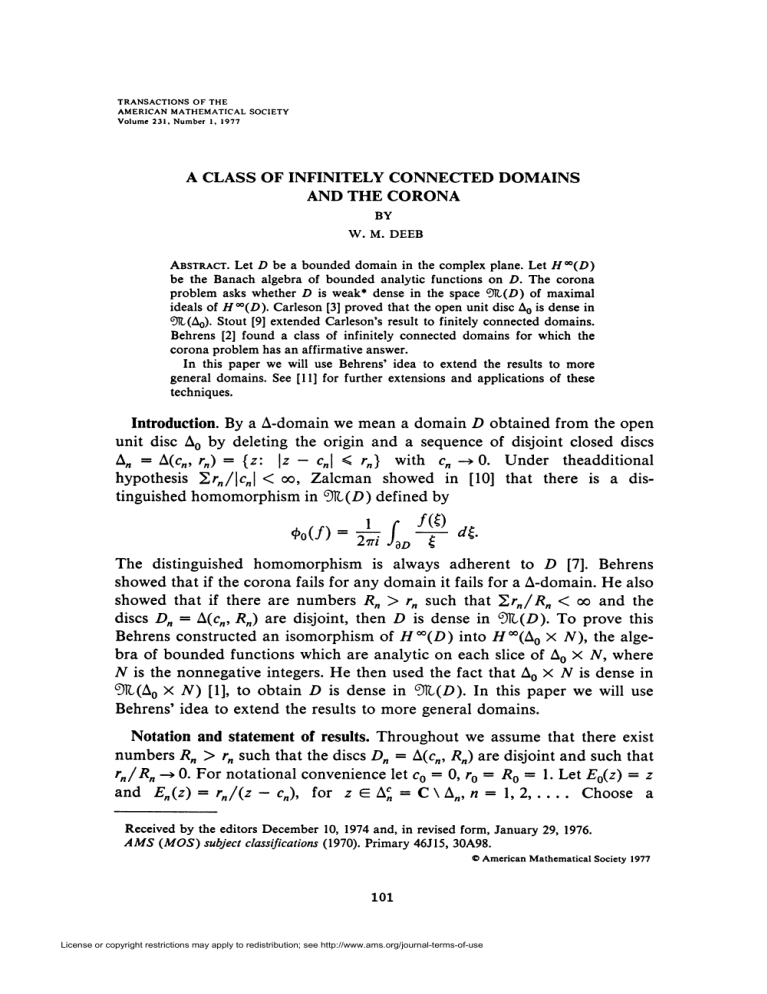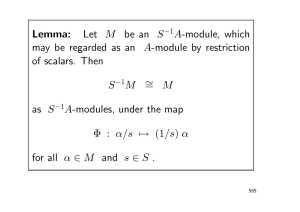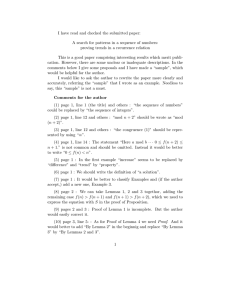w-sîJ[ tt - American Mathematical Society
advertisement

transactions
of the
american mathematical
society
Volume 231, Number 1, 1977
A CLASS OF INFINITELYCONNECTEDDOMAINS
ANDTHE CORONA
BY
W. M. DEEB
Abstract. Let D be a bounded domain in the complex plane. Let H°°(D)
be the Banach algebra of bounded analytic functions on D. The corona
problem asks whether D is weak* dense in the space 9H(D) of maximal
ideals of HK(D). Carleson [3] proved that the open unit disc A0 is dense in
911(A0). Stout [9] extended Carleson's result to finitely connected domains.
Behrens [2] found a class of infinitely connected domains for which the
corona problem has an affirmative answer.
In this paper we will use Behrens' idea to extend the results to more
general domains. See [11] for further extensions and applications of these
techniques.
Introduction. By a A-domain we mean a domain D obtained from the open
unit disc A0 by deleting the origin and a sequence of disjoint closed discs
A„ = A(c„, r„) = {z:
\z — cn\ < r„]
with
cn -» 0. Under
theadditional
hypothesis 2/"n/|c„| < oo, Zalcman showed in [10] that there is a dis-
tinguished homomorphism in 91t(D) defined by
*w-sîJ[ tt*
The distinguished homomorphism is always adherent to D [7]. Behrens
showed that if the corona fails for any domain it fails for a A-domain. He also
showed that if there are numbers Rn > rn such that "2rn/R„ < oo and the
discs Dn = A(c„, Rn) are disjoint, then D is dense in 911(D). To prove this
Behrens constructed an isomorphism of H^iD) into //°°(A0 x N), the algebra of bounded functions which are analytic on each slice of A0 X N, where
N is the nonnegative integers. He then used the fact that A0 X N is dense in
9H(A0 X N) [1], to obtain D is dense in 9H(£>). In this paper we will use
Behrens' idea to extend the results to more general domains.
Notation and statement of results. Throughout we assume that there exist
numbers Rn > r„ such that the discs D„ = A(c„, Rn) are disjoint and such that
rn/Rn-+ 0. For notational convenience let c0 = 0, r0 = R0 = 1. Let EQ{z)= z
and E„{z) = rj{z - c„), for z E Acn= C\A„, n = 1,2,_
Choose a
Received by the editors December 10, 1974 and, in revised form, January 29, 1976.
AMS (A/05) subjectclassifications
(1970).Primary46J15,30A98.
© American Mathematical Society 1977
101
License or copyright restrictions may apply to redistribution; see http://www.ams.org/journal-terms-of-use
102
W. M. DEEB
sequence of positive integers {kn} such that S(/•„//?„)*■ < oo. Let Ln(z) =
En(z)k"- En(0)k*
and L(z) - 24(0- ChooseS„ = y/ÍJX so that rjSn -* 0
and 5„//?„ -» 0, and let B„ = A(c„,S„).Let
X = 91t(A0X N)\ \ U 9ÎL(A0)X {n} .
For/E//°°(Z))let
M/) = ^//^*
and (W)-¿
/^*,
where z E A0if « = 0 and z S A£if n — 1, 2, 3,....
in 9H(Z)) at the origin and A0 = //"(Z))^.
Let ^ILgdenote the fiber
Theorem 1. Let D be a A-domainwith rn/Rn -» 0. If £ E 91tnand L(<(>)
^
0, //le« <£¿s adherent to D.
Theorem 2. Ler D be a A-domain. Suppose there exists a positive integer m
such that 2(rn/Rn)m < oo. Let <pE %.
but an(f) -> 0, then <pis adherent to D.
//, for some f E HM(D), <f>(f)+ 0
In [1] Behrens established that an-»<f>0 in norm if 1,rn/Rn < oo. Thus
Behrens' theorem can be regarded as a consequence of Theorem 2.
Preliminary lemmas and proofs.
Lemma 1. Let e > 0 be given. Then there exists a positive integer N such that,
forallfEH°°(D),\\f\\
< 1,
\f(z) - (PJ)(z) - a„(f)\ < e, forzEBn\Anandn>
N.
Proof. Choose N so that S„/(R„ - Sn) < e, n > N. Write/(z) = (P„f)(z)
+ an(f) + Fn(z), for z E Dn \ An, where
'.tt-Sv-O'
and *, = ¿/3on_i^C
Then \bnJ\< 1/RJ and, for z E B„\A„,n>
N,
\}(z) - (PJ)(z) - an(f)\ =\Fn(z)\ < I ^ = ^V
J-l
Ri
K»
Lemma 2. Let f„ E Hc0(Acn)with \\f„\\ < M, n = 1, 2,....
*■
< e-
Let
m=ÎL„(z)fn(z).
n= 0
Thenf E HX(D) and, given e > 0, there is a positive integer N such that
License or copyright restrictions may apply to redistribution; see http://www.ams.org/journal-terms-of-use
INFINITELY CONNECTEDDOMAINSAND THE CORONA
2
103
|L„(z)/„ (z)| < e for z E Dm,m > N.
n = 0; n¥=m
Moreover, an{f) -» 0.
Proof.
Observe
that am{f) = 2™„0.n^m{LJn){cm).
Incorporating
this
observation the proof is essentially the same as the analogous lemma in [2].
Define *: HM{D) -* HX{A0 X N) by
¥(/)(*, n) = (PJ) o E~x{z) + a„(f),
f E //°°(Z>).
Lemma 3. ^ is continuous.
Proof. An elementary computation shows there exists M > 0 such that
\\PJW < M\\f\\BMn, for all n, whenever lim sup{rn/Rn) < 1.
Lemma4. ||/||% = \\*(f)\\x>c"f * H<°(D).
Proof. \\f\\^ = lim sup||/||^XAn = lim supl^/)!!^,,}
= \\*{f)\\x.
The middle equality follows from Lemma 1, the left equality from a
well-known theorem concerning the Shilov boundary of the fiber algebra [6],
and the right equality from the definition of X and elementary properties of
HX(A0X N).
Lemma 5. ///, g E HX{D) then
Proof. Assume ||/|| < 1, ||g|| < 1. Let e > 0 be given. Then there exists a
positive integer N such that, for z E Bn \ A„, n > N,
(1) \f{z) - {PJ)(z) - an{f)\ < e/3;
(2)|g(z)-(P„g)(z)-an(g)|<e/3;
(3) KM*) - iPJs)(z) - an(fg)\< e/3.
Multiplying (1) and (2) and simplifyingwe get
|- (fg)(z)+[(PJ)(z)
+ an{f)][{Png){z) + an{g)]\ < £,
for z E B„ \ A„, n > N.
Adding to (3), we get
\[(PJ)(z)
+ an(f)][(Png){z) + an{g)} -[(PJg){z)
for z E Bn\A„,n>
+ an{fg)]\ < 2e,
N. Thus
|¥(/)(z,
n) ■*(g)(z,
n) - *(fg)(z,
for all z E A0,n > N. It follows that
License or copyright restrictions may apply to redistribution; see http://www.ams.org/journal-terms-of-use
n)\ < e,
104
W. M. DEEB
Summarizing, we have shown:
Proposition 1. ^induces a map ^: A0-+ H°°(A0 X N)\x. V is an algebra
isometric isomorphism of A0 with a closed subalgebra B0 of i/°°(A0 X A0|*-
The map 9: 9H(50)^%
^(Po)'f
defined by 6(cb)(f)= <b(*(f)), for <pE
e AQ,is a homeomorphism. Note that
¿7°°(A0X JV) = Z#°°(A0X
AT)+ /",
where Z is the "coordinate" function Z(X, n) = X. The sequence {an(f)} is
the /"-component of ¥(/).
Lemma6. lim^JI/-
«„(Z)^ = 0,/or/ E H<»(D).
Proof. From Lemma 1 it suffices to show limn_>00||i>,/||3s->0. But for
z E 9B„,
W)(*)\
i r m
r^ I ~t— c
■0.
Lemma7. Let T E HX(A0 X N) be defined by T(z, n) = zk\ Then *(L) =
Tand
TH™(A0XN)\x + CcBQ.
Proof. Let h = {zk\) E 77/°°(A0 x N) and let
/= ÎL„(h„oE„).
n=l
Then/ E HX(D) and ö„(/) -* 0, by Lemma 2. Also ¥(/) - %.
At this point recall some general facts. Let B be a commutative Banach
algebra, BQ a closed subalgebra of B, and / a closed ideal in5. If J c 50,
then every <bE <DH-So
which does not annihilate J has a unique extension to
•Dltfl. If furthermore, £0 = 7 + C, then 911^ is obtained from 91tB by
identifying the hull of J to a point.
If BQis as defined earlier, B = H°°(A0x ¿V)lxand / = TH°°(A0X AT)^,
then "Dlt^= X and the following lemma is immediate.
Lemma 8. If <bE ^St(B0) and ^>(T) =£ 0, then tj>extends to an evaluation
homomorphism at a point of X.
For the proof of Theorem 1, we need one final lemma.
Lemma 9. A homomorphism <f>E 9H(.B0) is an evaluation homomorphism at a
point of X if and only if the corresponding homomorphism 9(<f) in 9H0 is
adherent to U (Bn \ An).
License or copyright restrictions may apply to redistribution; see http://www.ams.org/journal-terms-of-use
INFINITELY CONNECTED DOMAINSAND THE CORONA
Proof.
105
Suppose wa is a net in U (Bn \ AJ converging to 4>E <Dt0,where
wa E B„a \ A^. Define (za, na) E A0 X N so that
£^(w0)
= za. Then na -> oo.
Passing to a subnet, we can assume (za, na) converges to c¡>*E X. If f E
Hx(D),then
/(*) = lim/K)
= lim(*/)(za, na) - */(<*>*)
so that 0(¿>*)= c>.
Conversely, suppose <p*E X. Since rn/Sn-+0,
X is adherent to
F=i/[£n(/in\An)X{«}]cA0XiV.
Choose
a net (za, «a) E V so that (za, wa)-»<i>*. Then na-> oo. Set wa =
E-\ztt) E 5^ \AV Since lim(*/)(za, na) = ¥/(**) exists for all / E
H°°{D), also lim/(H'a) exists. Hence wa converges to some <bE 91t(D).
Evidently <f>
E %, and d>= 9{<p*).
Proof of Theorem 1. Let cb*= t9_1(<i>).
Then c5*(T) = </>(L)^ 0. By
Lemma 8, £* extends to an evaluation homomorphism at a point of X. Thus
9 {$*) = <í>
is adherent to D by Lemma 9.
Corollary
1. Z>« dense in 9H(L>) ./a/ic/ o«/> if L~x{0) has no interior.
Note that Lemma 9 also establishes the following proposition:
Proposition 2. Suppose D is a A-domain with rn/Rn -* 0. // 9H(50) is the
quotient space of X obtained by identifying points not separated by B0, then D is
dense in 9H(/J>).
Since the proof of Theorem 1 works for any choice of positive integers {k„}
such that
2 LJn E tf°°, for/„ E H°°(A<),ll/JI < M, n - 1,2,...,
one might hope to deduce/) is dense in 9H(I>) merely under the hypothesis
rn/Rn-±0. We have not been able to do this. One difficulty is that the
hypothesis rn/Rn—>0 does not guarantee the existence of a distinguished
homomorphism in cÜ\l0.For example, take cn = 2~", rn = e„2-(n+2) and R„ =
2-Ci+O where 0 < e„ < I, e„-+ 0 and 2e„ = + oo.
Since this is an (L)-domain of the type treated by Zalcman in [10] and
2Zr„/cn = oo, it follows that there is no distinguished homomorphism in 91Lj.
Moreover a theorem of T. Gamelin and J. Garnett [7] shows that in this case
the sequence {a„) has a subsequence which is an interpolating sequence.
Proof of Theorem 2. Let <£*_=0~'(<f>), L{z) = 2{rn/(z - cn))m (rn/-cn)m
and T(z, n) = zm so T = *(L)
ZmHx (A0 XJV)|iC
= Zm\x. Then
50 by Lemma 7,
where Z denotes the coordinate function in //°°(A0 x N). Since a„(/)-»
License or copyright restrictions may apply to redistribution; see http://www.ams.org/journal-terms-of-use
106
W. M. DEEB
0, ¥(/) E ZHK(A0 X N)\x and [*(/)]m = *(/*") £ ZmH'x>(AÇi
X n)|,. Now
0 ^ #/») = <|>*[*(/m)]. Thus <í>*is not zero on ZmH™(AQX N)\x and
<?*(T)7e 0. By Theorem 1, <¡>(L)
= <¡>*(T)
i- 0 and £ is adherent to Z).
Corollary
2. Suppose there exists a positive integer m such that 2Z(rn/Rn)m
< oo and suppose, for every f E Hœ(D), an(J) converges.
Then D is dense in 911(Z>).
Proof. Define <p0(f)= lim an(f),f E H">(D). By Lemma 6, d>0E 91tn(Z>)
and <i>0
is adherent to D. If 4>E "Sltg\ (<i>0},
Theorem 2 shows <i>
is adherent to
D.
We would like to thank the referee for many useful comments and
criticisms.
References
1. M. F. Behrens, The corona conjecturefor a class of infinitely connected domains. Bull. Amer.
Math.Soc.76 (1970),387-391.MR 41#825.
2. _,
The maximal ideal space of algebras of bounded analytic functions on infinitely
connecteddomains,Trans. Amer. Math. Soc. 161 (1971),359-379.
3. L. Carleson, Interpolations by bounded analytic functions and the corona problem, Ann. of
Math. (2)76 (1962),547-559.MR 25#5186.
4. T. W. Gamelin, Localizationof the coronaproblem, Pacific J. Math. 34 (1970),73-81. MR
43#2482.
5._,
6._,
Uniformalgebras, Prentice-Hall, Englewood Cliffs, N.J., 1969.
Lectures on HX(D), La Plata Notas de Math. No. 21 (1972).
7. T. W. Gamelin and J. Garnett, Distinguished homomorphisms and fiber algebras, Amer. J.
Math. 92 (1970),455^174.MR 46 #2434.
8. K. Hoffman, Banach spaces of analytic functions, Prentice-Hall, Englewood Cliffs, N.J.,
1962.MR 24 #A2844.
9. E. L. Stout, Two theorems concerning functions holomorphic on multiply connected domains,
Bull.Amer.Math. Soc.69 (1963),527-530.MR 27#275.
10. L. Zalcman, Bounded analytic functions on domains of infinite connectivity, Trans. Amer.
Math. Soc.144(1969),241-269.MR 40 #5884.
11. W. M. Deeb and D. R. Wilken, à-domains and the corona, Trans. Amer. Math. Soc. 231
(1977), 107-115.
Department of Mathematics, State University of New York at Albany, Albany, New
York 12222
License or copyright restrictions may apply to redistribution; see http://www.ams.org/journal-terms-of-use








